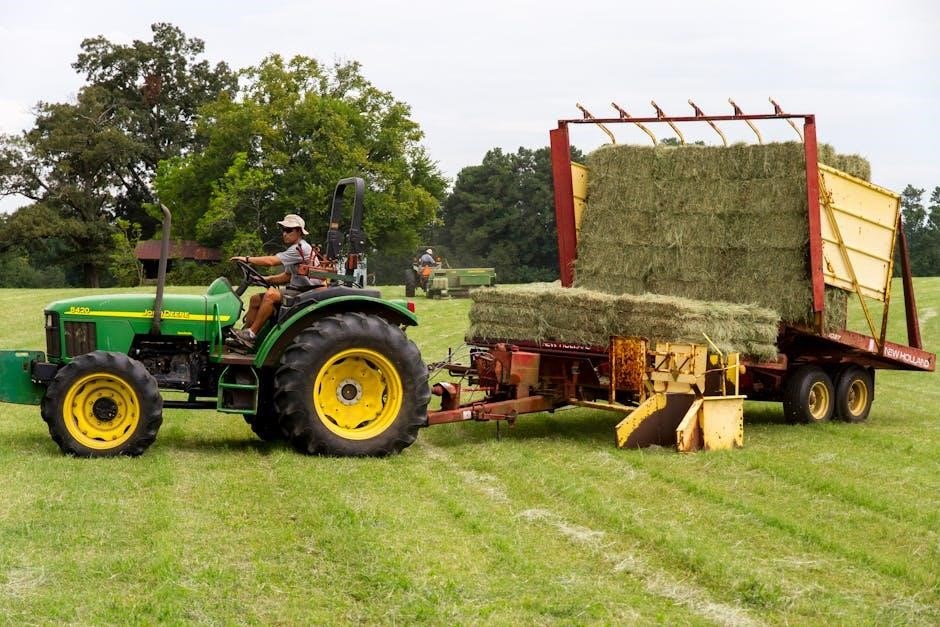
A manual hay baler is an essential agricultural tool designed to compress cut hay, straw, or forage into compact bales efficiently․ Ideal for small-scale farming, it offers an economical and sustainable solution for managing hay production, promoting eco-friendly practices and reducing labor costs while ensuring high-quality hay bales for livestock feeding․
What is a Manual Hay Baler?
A manual hay baler is a device designed to compress cut hay, straw, or other forage into compact bales․ It operates without electricity, relying on physical effort to bundle and secure the material․ Typically constructed from durable materials like shaped steel or wood, these balers are simple, cost-effective tools ideal for small-scale farming․ They produce uniform bales, usually of smaller dimensions, making them accessible for farmers with limited resources․ The manual operation ensures a sustainable, eco-friendly solution for hay management․
Importance of Manual Hay Balers in Agriculture

Importance of Manual Hay Balers in Agriculture
Manual hay balers play a vital role in sustainable farming by enabling efficient hay management․ They are cost-effective, reducing reliance on expensive machinery, and support small-scale agriculture․ These balers minimize waste by compressing hay into compact bales, preserving nutrients for livestock․ Their eco-friendly design promotes environmentally responsible farming practices․ Additionally, manual balers empower farmers to maintain control over hay production, ensuring high-quality output while lowering operational costs․ This makes them indispensable for farmers prioritizing sustainability and resource efficiency in their agricultural operations․

How a Manual Hay Baler Works
A manual hay baler compresses hay into bales using human effort․ It typically involves feeding hay into a chamber, compressing it with a lever or handle, and securing the bale with twine․
Basic Components of a Manual Hay Baler
A manual hay baler consists of a sturdy frame, a compression chamber, a lever or handle for applying pressure, and a mechanism for securing the bale with twine or wire․ It also includes a feeding chute for loading hay and a plunger or ram to compress the hay tightly․ Some models may incorporate a bale ejector for easy removal of the finished bale․ These components work together to simplify the baling process, making it efficient and accessible for small-scale operations․
Step-by-Step Process of Baling Hay Manually
Start by gathering and arranging the hay into manageable portions․ Load the hay into the baler’s feeding chute, ensuring even distribution․ Use the lever or handle to compress the hay tightly within the chamber․ Once compressed, secure the bale with twine or wire․ Finally, eject the bale from the machine․ Repeat the process to create multiple bales․ This manual method requires physical effort but ensures efficient hay management for small-scale farming needs․
Benefits of Using a Manual Hay Baler
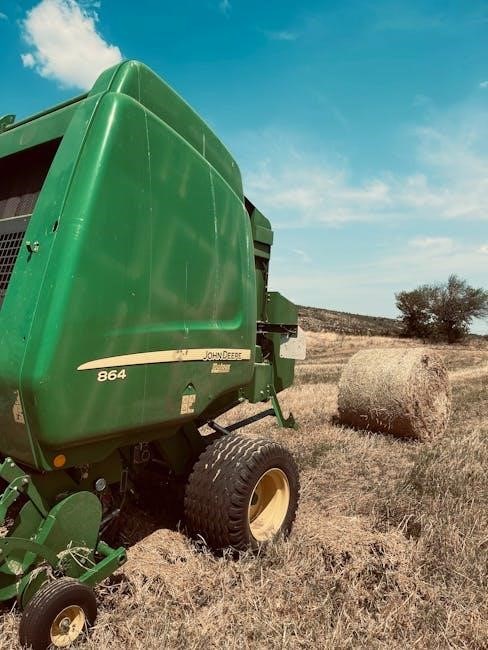
Manual hay balers offer cost-effectiveness, environmental benefits, and suitability for small-scale farming, promoting sustainable practices and efficient hay management without reliance on heavy machinery․
Cost-Effectiveness of Manual Hay Balers
Manual hay balers are a budget-friendly option for small-scale farmers, offering significant savings on initial purchase and operating costs compared to automatic models․ They require no fuel or electricity, reducing energy expenses․ Additionally, manual balers are durable, with minimal maintenance needs, further lowering long-term costs․ This makes them ideal for farmers with limited resources or smaller hay production needs, providing an economical solution for efficient hay management without compromising on productivity․
Environmental Advantages of Manual Baling
Manual hay balers offer eco-friendly benefits by eliminating the need for fuel or electricity, reducing carbon emissions․ They operate silently, minimizing noise pollution and creating a more peaceful working environment․ By using sustainable materials and natural fibers, manual balers promote eco-conscious farming practices․ Additionally, they help conserve energy resources and reduce reliance on fossil fuels, making them a greener choice for small-scale agriculture and supporting environmentally responsible hay management․
Design and Construction of Manual Hay Balers
Manual hay balers are typically built with durable materials like steel or wood, ensuring longevity and reliability․ Their compact, lightweight design allows for easy portability and operation․
Materials Used in Building a Manual Hay Baler
Manual hay balers are constructed using durable materials such as steel, aluminum, or wood․ Steel is preferred for its strength and longevity, while aluminum offers lightweight portability․ Wood is often used for frames due to its cost-effectiveness and ease of repair․ High-quality ropes or wires are essential for binding hay securely․ Additionally, some models incorporate plastic or rubber components for smoother operation․ The choice of materials ensures the baler is robust, reliable, and suitable for small-scale farming or hobbyist use․
Key Features of an Efficient Manual Hay Baler Design
An efficient manual hay baler design includes a sturdy frame, easy-to-operate levers, and a reliable baling chamber․ It should have adjustable settings for varying hay densities and sizes․ Durable gears and a smooth feeding mechanism ensure consistent performance․ Portable designs with wheels or lightweight materials enhance mobility․ Safety features, such as emergency release mechanisms, prevent accidents․ User-friendly designs with clear instructions make operation accessible for all skill levels, ensuring productivity and ease of use in small-scale farming environments․
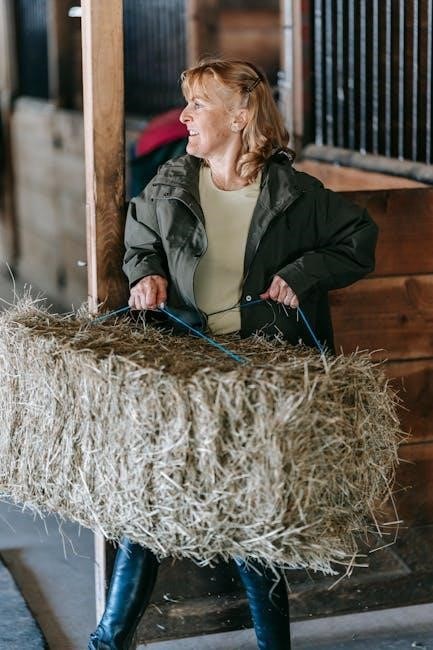
Choosing the Right Manual Hay Baler
Selecting the ideal manual hay baler involves considering factors like size, capacity, durability, and ease of use․ Prioritize models that align with your specific farming needs and budget for optimal efficiency and long-term performance in hay management tasks․
Factors to Consider When Selecting a Manual Hay Baler
When choosing a manual hay baler, consider factors like capacity, durability, and ease of operation․ Assess the types of hay you work with, as some balers are designed for specific materials․ Evaluate the construction quality and materials used to ensure longevity․ Additionally, consider the cost and whether it aligns with your budget․ Portability, safety features, and user-friendly design are also important to enhance efficiency and reduce labor strain during hay baling tasks․ Prioritize models that meet your farm’s unique requirements for optimal performance․
Comparison of Different Manual Hay Baler Models
Manual hay baler models vary in size, capacity, and features․ Compact models are ideal for small-scale farming, while larger designs suit extensive hay baling needs․ Some models feature durable steel frames, while others use lightweight yet robust materials․ Advanced versions may include multiple compression settings or ergonomic handles for ease of use․ Comparing these aspects helps farmers select a baler that aligns with their workload and operational preferences, ensuring efficiency and reliability in their hay baling operations․

Maintenance and Repair of Manual Hay Balers
Regular lubrication of moving parts and thorough cleaning ensure optimal performance․ Inspect for wear and tear, replacing damaged components promptly to prevent breakdowns and extend lifespan․
Regular Maintenance Tips for Longevity
Regular maintenance is crucial for extending the life of a manual hay baler․ Lubricate all moving parts frequently to reduce friction and wear․ Clean the baler thoroughly after each use to remove dirt and hay residue, which can cause jams․ Inspect belts, gears, and blades for wear and tear, replacing them when necessary․ Store the baler in a dry, sheltered area to protect it from rust and moisture․ Tighten any loose bolts or screws to ensure stability and safety during operation․
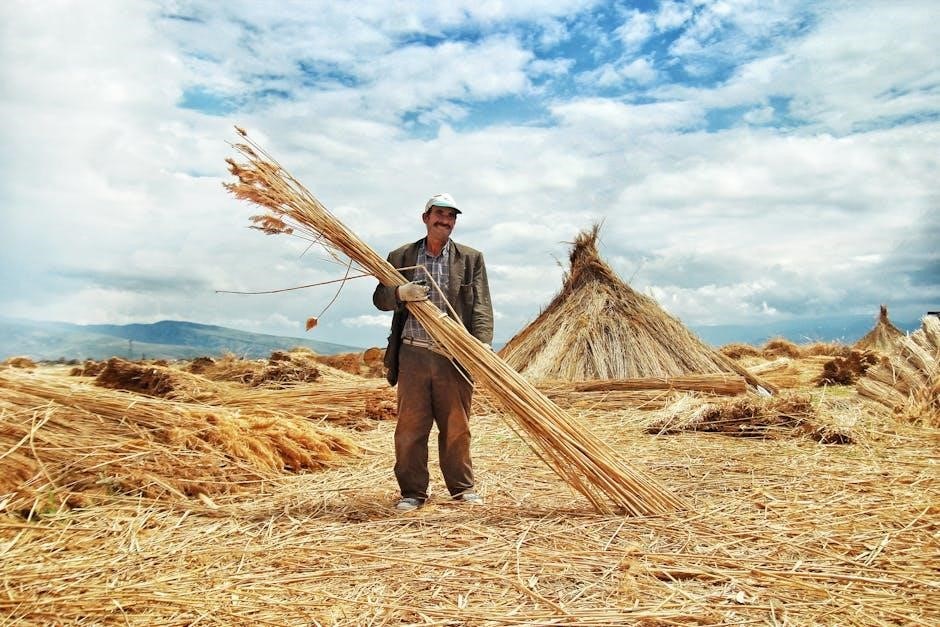
Common Issues and DIY Repair Solutions
Common issues with manual hay balers include jammed mechanisms, worn-out belts, and rusted parts․ For jams, clear blockages and ensure proper hay loading․ Replace worn belts or blades promptly to maintain efficiency․ Rust can be addressed by sanding affected areas and applying a rust-resistant coating․ Lubricate moving parts regularly to prevent friction damage․ If the baler is not compacting hay properly, check and tighten loose screws or bolts․ Always refer to the user manual for specific repair guidance to avoid further damage․
Safety Precautions When Using a Manual Hay Baler
Always wear protective gear like gloves and safety glasses․ Ensure the area is clear of debris․ Proper training is essential for safe operation․ Follow manufacturer instructions and avoid loose clothing that could get caught․ Keep children away while operating the baler․
Best Practices for Safe Operation
Always inspect the manual hay baler before use, ensuring all parts are secure and functioning properly․ Wear sturdy gloves and protective eyewear to prevent injuries․ Properly train all operators to handle the equipment safely․ Keep loose clothing tied back and avoid jewelry that could get caught․ Operate the baler in a well-ventilated area, away from open flames or sparks․ Never overload the baler, as this can cause mechanical failure․ Follow the manufacturer’s guidelines for maximum capacity and baling techniques․ Ensure children and pets are kept at a safe distance during operation․
Preventing Accidents with Proper Usage
Preventing accidents with a manual hay baler requires proper training, adherence to safety guidelines, and regular equipment checks․ Always follow the manufacturer’s instructions and ensure operators understand the machinery․ Keep the workspace clear of obstacles to avoid tripping hazards․ Maintain a firm grip on handles to prevent slipping․ Store bales securely to prevent them from rolling․ Regular lubrication of moving parts reduces wear and tear, ensuring smooth operation and safety․ A well-maintained baler minimizes risks and enhances efficiency․
The History of Manual Hay Balers
Manual hay balers originated in traditional agriculture, evolving from simple tools to more efficient designs, revolutionizing hay management and farming practices over centuries․
Evolution from Traditional Methods to Modern Designs
The transition from manual labor to mechanical aids marked the beginning of hay baler evolution․ Early designs relied on simple levers and frames, while 19th-century innovations introduced compact, portable models․ Over time, materials like steel and iron improved durability․ By the mid-20th century, manual balers became more efficient, with designs emphasizing ease of use․ Modern versions incorporate lightweight frames, adjustable compression settings, and eco-friendly materials, blending tradition with innovation to meet contemporary farming needs while maintaining affordability and simplicity․
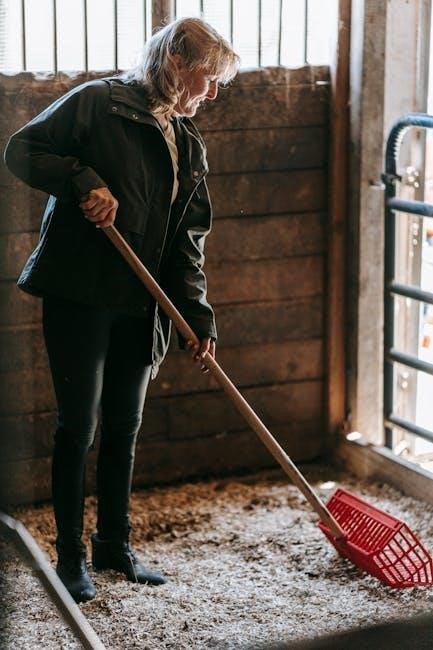
Impact of Manual Hay Balers on Farming Practices
Manual hay balers revolutionized farming by enabling efficient hay management, reducing waste, and improving resource utilization․ They allowed farmers to bale hay during optimal drying times, preserving quality and reducing spoilage․ By simplifying the process, manual balers made it accessible for small-scale farmers, promoting self-sufficiency․ Their eco-friendly nature aligns with sustainable farming practices, lowering costs and environmental impact․ This innovation has significantly enhanced agricultural productivity, especially for those with limited resources, fostering a more efficient and sustainable farming industry․

Efficient Hay Baling Techniques
Timing baling during optimal hay dryness and organizing hay neatly ensures efficient manual baling, reducing waste and improving storage․
Optimizing Hay Density for Better Results
Optimizing hay density is crucial for efficient baling․
Proper moisture levels ensure hay packs well without rotting․
Consistent pressure during baling creates uniform density․
Manual balers require even force for tight bales․
Proper twine tension prevents loose bales․
Higher density reduces storage space and transportation costs․
Additionally, monitoring hay dryness and adjusting baling techniques can further enhance density․
This ensures each bale is compact and secure, leading to better storage and handling efficiency․
Time-Saving Strategies for Manual Baling
Efficient workspace organization is key to saving time․
Preparing hay and tools in advance streamlines the process․
Selecting the right bale size reduces the number of bales needed․
Regularly cleaning the baler prevents jams and downtime․
Implementing a smooth workflow minimizes unnecessary movement․
Storing supplies nearby reduces retrieval time․
Using batch processing for multiple bales saves effort․
Training others to assist can halve the workload․
Leveraging the right tools ensures quick and precise baling․
Planning baling sessions during optimal weather avoids delays․
Manual vs․ Automatic Hay Balers
Manual hay balers are cost-effective, ideal for small-scale farming, and environmentally friendly, whereas automatic balers offer high-speed operation for large-scale agricultural needs․
Pros and Cons of Manual Hay Balers
Manual hay balers are cost-effective, eco-friendly, and ideal for small-scale farming․ They require minimal investment, operate without electricity, and produce minimal noise․ However, they are labor-intensive, time-consuming, and have limited capacity compared to automatic balers․ They also require physical effort and skill to operate efficiently․ Despite these drawbacks, manual balers are a sustainable choice for farmers with small fields or those prioritizing environmental conservation․ They offer a reliable solution for hay management without reliance on advanced technology․
When to Choose a Manual Over an Automatic Baler
A manual hay baler is ideal for small-scale farming, limited budgets, or environments with unreliable electricity․ It’s perfect for small fields, hobby farms, or situations where only small batches of hay need baling․ Manual balers are also eco-friendly, producing no emissions, and are suitable for farmers who value sustainability․ They are portable and require minimal storage space, making them a practical choice for those with limited resources or who prefer a non-mechanized approach to hay management․
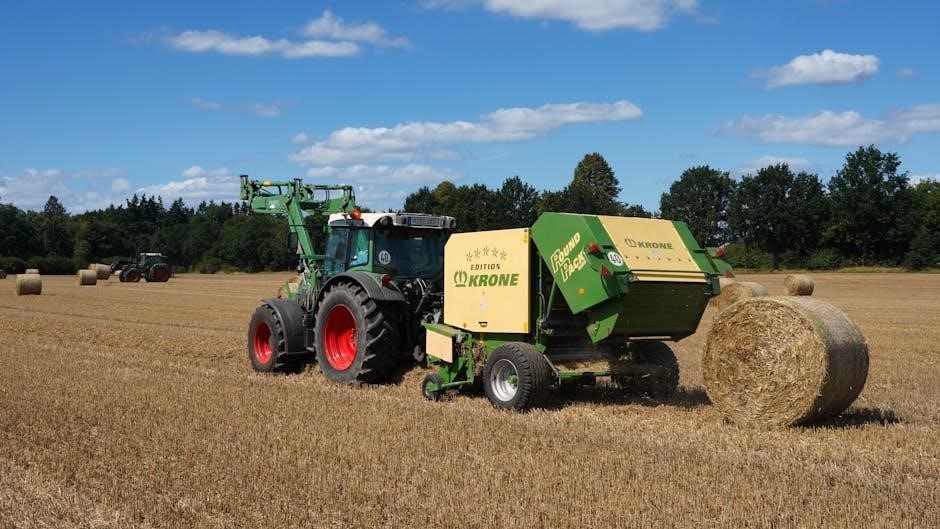
Innovations in Manual Hay Baling Technology
Modern manual hay balers feature durable materials, ergonomic designs, and improved mechanisms for easier operation and higher efficiency, enhancing traditional baling methods without automation․
Modern Improvements in Manual Hay Baler Design
Recent advancements in manual hay baler design include lightweight yet durable materials like steel alloys and high-strength plastics, reducing weight while maintaining strength․ Adjustable compression settings now allow users to customize bale density based on hay type, improving versatility․ Enhanced safety features such as emergency release mechanisms and protective guards have been integrated to minimize accidents․ Additionally, ergonomic handles and improved gearing systems reduce operator fatigue, making the baling process more efficient․ These innovations ensure manual balers remain relevant and user-friendly in modern farming practices․
Future Trends in Manual Hay Baling Equipment
Future trends in manual hay baling equipment emphasize sustainability and efficiency․ Innovations like solar-powered balers and eco-friendly materials are expected to rise, reducing environmental impact․ Smart designs incorporating IoT for real-time monitoring and maintenance predictions are anticipated․ Compact, portable models tailored for small-scale farmers and urban agriculture will gain popularity․ Additionally, advancements in energy-saving mechanisms and ergonomic designs will enhance user experience, making manual hay balers more adaptable to diverse farming needs while promoting eco-conscious practices globally․
Manual hay balers remain a reliable, efficient, and cost-effective solution for small-scale farming, offering sustainable practices and eco-friendly benefits, making them a valuable tool for modern agriculture․
Final Thoughts on the Usefulness of Manual Hay Balers
Manual hay balers are indispensable tools for small-scale farmers, offering cost-effective and eco-friendly solutions for hay management․ Their simplicity ensures reliability and ease of use, making them ideal for sustainable farming practices․ By reducing reliance on machinery and lowering costs, manual hay balers promote environmentally conscious agriculture․ They remain vital for farmers seeking efficient, low-maintenance equipment that supports traditional farming methods while contributing to a greener future․
Encouraging Sustainable Farming with Manual Hay Balers
Manual hay balers play a crucial role in promoting sustainable farming by minimizing environmental impact․ They reduce fuel consumption and emissions, as they rely on manual power rather than gasoline․ This eco-friendly approach supports small-scale agriculture and organic farming practices․ By encouraging efficient hay management, manual balers help farmers reduce waste and optimize resources․ Their use aligns with renewable energy principles, fostering a greener and more sustainable agricultural future․